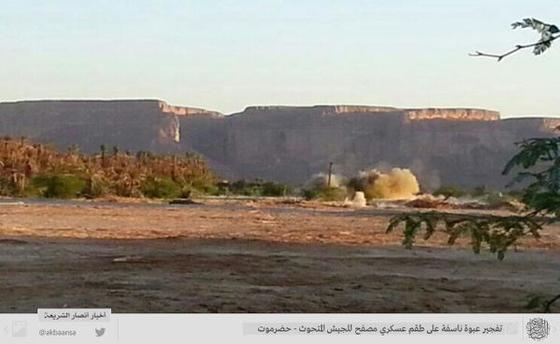Fighting that has raged for well over a month between al Qaeda in the Arabian Peninsula (AQAP) and Shiite Houthi rebels in Yemen’s central Baydah and Dhamar provinces is showing no indications of slowing down. On the contrary, AQAP is claiming credit for new IED and shooting attacks against Houthi military positions and personnel and even the targeting of Houthi leaders, activists, and residences in central Yemen.
AQAP released statements via Twitter claiming four improvised explosive device (IED) attacks against Houthi military vehicles in Baydah province between Nov. 21 and Nov. 23.
According to AQAP, at 11:50 a.m. on Nov. 21 its fighters detonated an IED as a Houthi military vehicle was driving along the supply route in the Bani Ali region of Mekerib in Qayfat Radaa, killing 12 Houthis on board. The following day, on Nov. 22, AQAP fighters staged an identical attack at 1:00 p.m. in the al Aleeb region of Baydah, close to the village of Khobza, which had been captured by the Houthis after three days of fierce clashes with AQAP that started on Nov. 13.
Another statement claimed that on Nov. 23, AQAP fighters carried out two additional IED attacks against Houthi military vehicles. At 9:00 a.m., an IED detonated as a Houthi vehicle passed along the Bani Ali region of Mekerib in Qayfat Radaa, the site of an identical attack two days prior, resulting in the deaths of seven Houthis. “A number of Houthis” were killed later in the day in the Hammat Bani Sarar region of Radaa by an IED attack that burned their vehicle completely. The AQAP statement said the number of casualties could not be determined.
In addition to the attacks on Houthi military vehicles, AQAP also claimed credit for twin IED attacks at 11:00 a.m. on Nov. 22 targeting “two residences owned by two Houthis in the city of Radaa,” Hussein Bujeir and Shareef al Jawfi. According to AQAP, the attacks wounded Houthis who were in the two houses, but did not cause any deaths. The following day, on Nov. 23, tribal fighters launched a rocket-propelled grenade (RPG) at another Houthi residence in Radaa; the AQAP statement said the fighters were from the village of Khobza, and that the attack killed four Houthis inside the house.
The attacks on Houthi residences in Radaa in Baydah province followed AQAP assassinations in Dhamar and Abyan provinces.
AQAP claims that fighters from its Farouq Brigades based in Radaa opened fire on Hashem Rawiya, a Houthi activist, killing him in his shop in the city of Dhamar on Nov. 20. The AQAP statement boasted that the Farouq Brigade had also assassinated Houthi leader Khaled al Washli, who was killed in Dhamar on Nov. 17.
And on Nov. 21, AQAP detonated an IED planted inside a television set as Houthi supporter and electric engineer Abu Salem Khaled Ahmad Ali Salem attempted to repair it in the city of Lawdar in Abyan province. AQAP claimed that Abu Salem was broadcasting Houthi propaganda and serving as a media official for the Shiite rebel group.
While escalating its operations against Houthi advances in central Yemen, AQAP is also continuing its campaign against the Yemeni military, particularly in the eastern portion of the country. Most recently, the terrorist organization claimed credit for a Nov. 22 IED attack on an armored military vehicle traveling from Wadi Sir towards the Special Forces Base in Qatn, located in central Hadramout province. According to AQAP, the vehicle was directly hit at 4:45 p.m. with enough force to turn it over, resulting in the deaths of an undetermined number of soldiers on board.
The following photo was released along with the statement about the IED attack on Nov. 22 in Hadramout:
“Detonation of an IED on an armored military vehicle belonging to the Houthi-turned military – Hadramaout”
Are you a dedicated reader of FDD's Long War Journal? Has our research benefitted you or your team over the years? Support our independent reporting and analysis today by considering a one-time or monthly donation. Thanks for reading! You can make a tax-deductible donation here.








